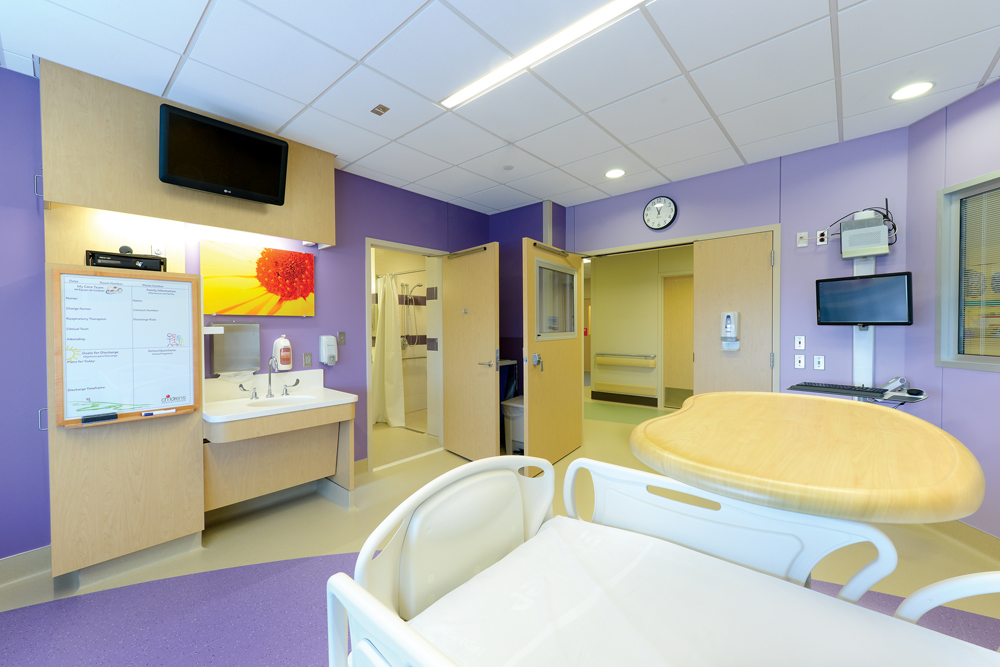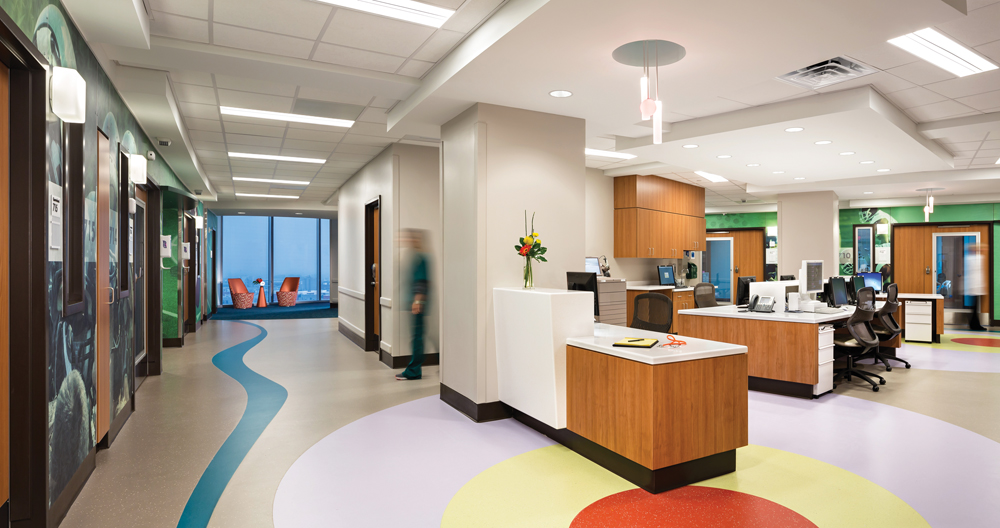Pediatric hospitals face many of the same concerns as their adult counterparts. The most consistent concern is change. Nationally, inpatient bed demand is declining, outpatient visits are soaring, and there is a higher level of focus on prevention and reduced readmissions.
The solution is not as simple as swapping inpatient space with outpatient care to meet the shifting demand. Many facilities have been operating 40% or more of their beds as semiprivates and—driven by reimbursement incentives for patient satisfaction and consumers’ penchant for choosing care based on public performance scores—hospital owners have no choice but to invest their limited capital dollars in new or renovated space to achieve 100% private-bed models.
In certificate of need (CON) states, owners are reluctant to reduce total bed counts due to the uncertainty in future bed demand. To effectively operate within this changing environment, owners look to the healthcare design and construction industry for creative facility solutions that offer highly flexible environments that promote healing.
Flexible Spaces, for Toddlers and Teens
Flexibility is key in helping owners address rapidly changing demands. While this is also true in adult care, children’s hospitals face a greater challenge due to the drastic difference in their patient dynamic. Caring for a patient in the NICU is significantly different than caring for a 16-year-old. Add the fact that pediatric inpatient volumes are sporadic at best, and you have an operational challenge in achieving ideal staff-to-patient ratios.
Children’s Medical Center Dallas has addressed uncertainty by designing patient rooms with a universal care model so they can be converted to ICU rooms with no construction impact. This will allow the hospital to flex with future trends.
Another way pediatric facilities are creating greater flexibility is by developing inpatient units that are more appropriate for all ages instead of just focusing on babies. In doing this, not only does the physical environment need to be highly adaptable to accommodate pediatric patients—i.e., adjustable sink heights, grab bars, and so on—but the design aesthetic must also evolve. Interiors need to move away from cutesy baby motifs to ones more appropriate for a wider age spectrum, from toddlers to teens.
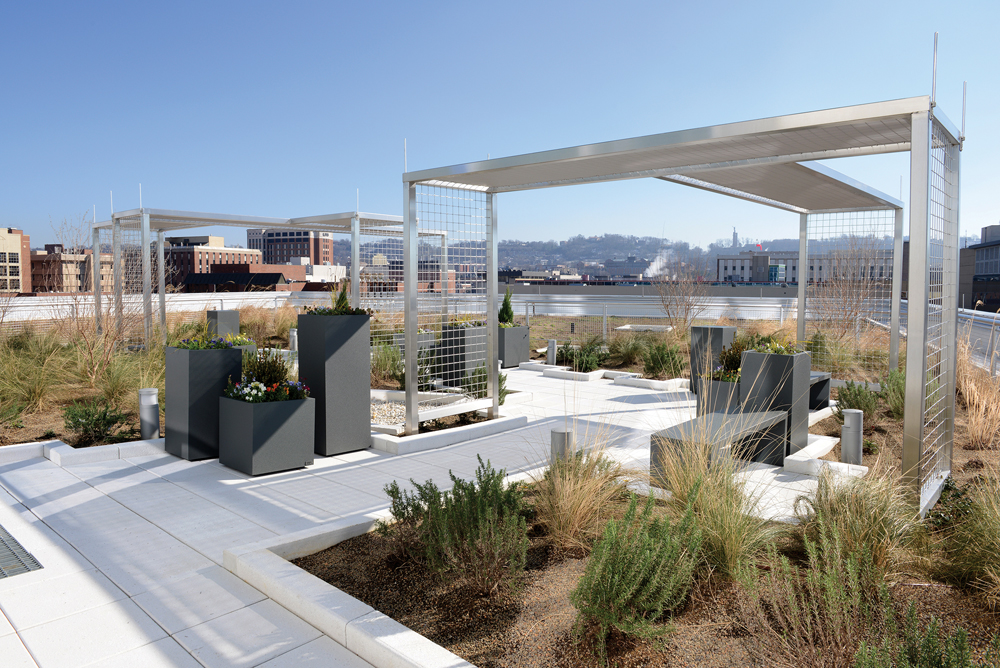
The rooftop garden provides a healing respite in an urban setting and is part of the LEED Gold-certified Benjamin Russell Hospital for Children’s environmentally friendly design.
Children’s of Alabama (COA) in Birmingham, Ala., was faced with these issues before opening its new facility, the Benjamin Russell Hospital for Children, in August 2013. To address these concerns, significant time was spent planning the design and “theme” for each floor. Wall surrounds and digital graphics portray wildlife, sports, nature, transportation, and other easy-to-remember themes. These were carried out in the hallways, common areas, and patient rooms. This strategy not only created a more inviting and comforting space for patients of all ages but also helped in the hospital’s wayfinding efforts. While a parent or child may not remember their room number, they would remember that they are in the “sports” tower, on the baseball floor, with a glove and ball by their room.
Tailoring the Healing Environment
Pediatric hospitals are not alone in their journey to becoming more patient-centered and family-focused, but the creative environments found in today’s children’s facilities puts them light years ahead of their adult-hospital peers. By engaging patients and their families in the design process, leaders are identifying what is most important for comfort and satisfaction.
Customization is increasingly popular. For example, integrating LED lights can enable patients to select their own wall and ceiling colors, giving them ultimate control over the look of their rooms. To further accommodate a broad age span, each patient room at COA is outfitted with an Xbox game console. These systems are tied into the hospital’s Patient Entertainment and Information System to provide an added layer of comfort. Patients, and more importantly their parents, are able to use the systems to research an illness, identify hospital services, and communicate with staff. One patient even commented, “Honestly, the hospital felt more like a hotel than a hospital.”
For larger pediatric units, playrooms for toddlers and teen rooms equipped with Wii stations offer on-unit destinations that allow patients a respite, inviting them to explore and to meet other children. Rooftop gardens are becoming more popular, making a bit of the outdoors accessible. COA’s rooftop garden, near the NICU, is designed to be a healing garden. The Building Team situated the “Quarterback” (West) Tower so that the end caps on each floor overlook Regions Field, home of the Birmingham Barons baseball team. On Friday nights, children can congregate at the end of the hall or in the garden to enjoy the weekly fireworks display.
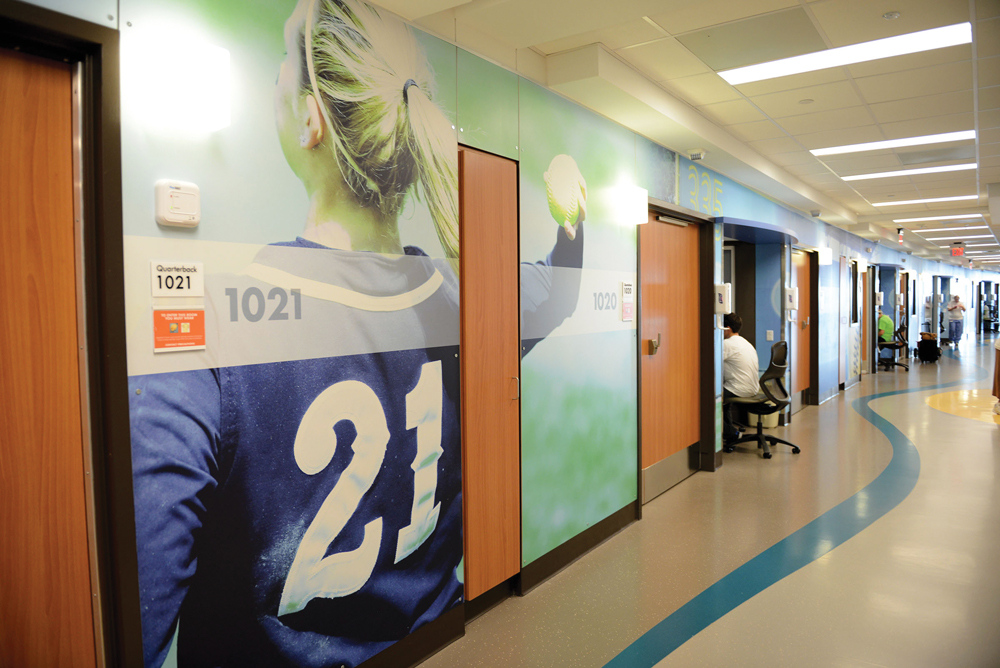
Family friendly themed wall-surrounds, vibrant colors, and a bold room numbering system combine with a wavy “blue river” pattern in the flooring at the Benjamin Russell Hospital for Children help patients and families with wayfinding.
Dedicated family space has also become very popular for children’s hospitals. “Family” zones, in patient rooms and in common areas, are designed to keep family members closer to their children, allowing for some privacy and comfort. The concept focuses on the family’s interaction with the hospital staff and their child to ensure a desirable flow. At design meetings, nursing staff often stress the importance of having a specific zone to accommodate parents within the patient room. In some instances, patient floors have been fitted with a family waiting area equipped with a kitchenette. This feature allows families to feel more at home during lengthy stays by giving them access to a refrigerator, sink, and microwave. Guest laundry areas may also be located on the unit for parent use.
Staff Space: Allow for Decompression
The distinctiveness of a children’s hospital transcends facility design. Staff play a critical role in the care and comfort of the children and their families. Staff often use the term “frequent flyers” to describe parents and children who must come to the hospital regularly for care. Even the security officers stationed at the door become very involved in the lives of these families and children. Staff at all levels, not just the caregivers, get to know the families and will go the extra mile to make their experience as pleasant and stress-free as possible.
Because the work is demanding, Building Teams should give special attention to the caregiver and staff areas of a pediatric facility. Make opportunities for staff to be “offstage” by providing inviting break areas, dining facilities, and outdoor spaces. These features enable staff to decompress during their workday, resulting in improved clinical performance when staff members are “onstage” caring for kids.
Hospitals are not typically envisioned as warm and inviting places. However, changes in design and care standards are creating spaces that provide patients and their families with much more comfort. From the outside “curb appeal” to the internal operations and systems, children’s hospitals are striving to achieve low-stress environments that aid in the healing and wellness of our smallest patients.
Staff spaces are open and comfortable, providing easy access to patient rooms. Glass end caps and sub-waiting areas at the end of each hallway provide expansive views of the city and Birmingham’s Regions Field at Children’s of Alabama.
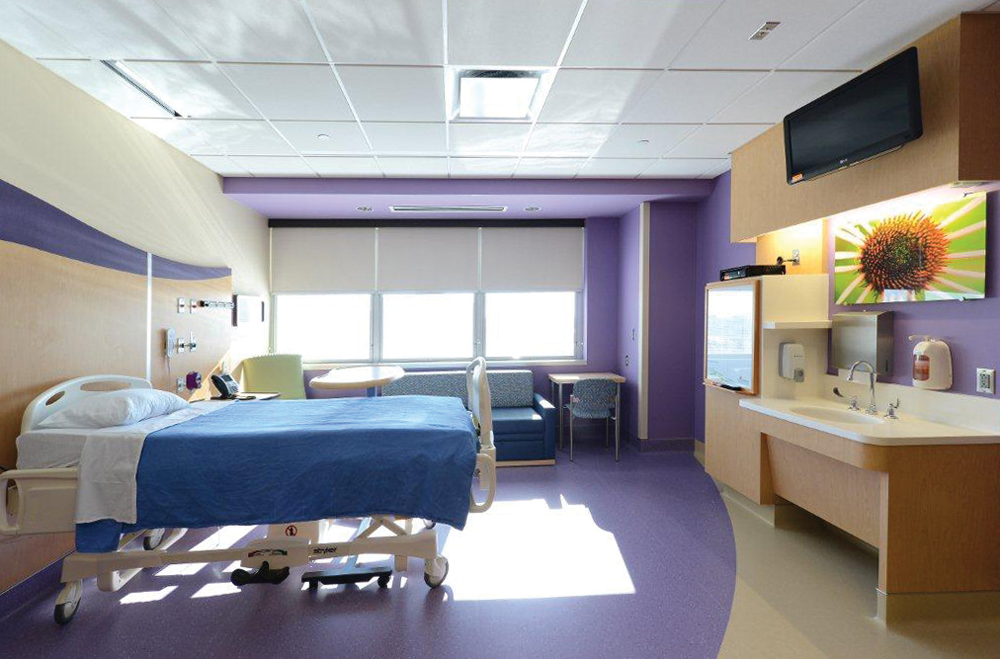
Spacious accommodations, warm aesthetics, and stimulating amenities aim to promote a relaxing environment for patients and their families throughout the healing process at Children’s Medical Center.
ABOUT THE AUTHORS
The authors of this article are affiliated with healthcare consulting firm CBRE Healthcare, based in Richmond, Va. They are Lora Schwartz, AIA, LEED AP, Principal; Stephen Powell, Consultant; Brad Durham, MBA, Principal; Magnus Nilsson, RA, Senior Consultant; Steven Donnelly, Vice President; and Curtis Skolnick, MHA, Vice President.
Related Stories
| Aug 11, 2010
Design firms slash IT spending in 2009
Over half of architecture, engineering, and environmental consulting firms (55%) are budgeting less for information technology in 2009 than they did in 2008, according to a new report from ZweigWhite. The 2009 Information Technology Survey reports that firms' 2009 IT budgets are a median of 3.3% of net service revenue, down from 3.6% in 2008. Firms planning to decrease spending are expected to do so by a median of 20%.
| Aug 11, 2010
A glimmer of hope amid grim news as construction employment falls in most states, metro areas
The construction employment picture brightened slightly with 18 states adding construction jobs from April to May according to a new analysis of data released today by the Bureau of Labor Statistics (BLS). However, construction employment overall continued to decline, noted Ken Simonson, the chief economist for the Associated General Contractors of America.
| Aug 11, 2010
Thom Mayne unveils 'floating cube' design for the Perot Museum of Nature and Science in Dallas
Calling it a “living educational tool featuring architecture inspired by nature and science,” Pritzker Prize Laureate Thom Mayne and leaders from the Museum of Nature & Science unveiled the schematic designs and building model for the Perot Museum of Nature & Science at Victory Park. Groundbreaking on the approximately $185 million project will be held later this fall, and the Museum is expected to open by early 2013.
| Aug 11, 2010
SOM's William F. Baker awarded Fritz Leonhardt Prize for achievement in structural engineering
In recognition of his engineering accomplishments, which include many of the tallest skyscrapers of our time, William F. Baker received the coveted Fritz Leonhardt Prize in Stuttgart, Germany. He is the first American to receive the prize.
| Aug 11, 2010
American Concrete Institute forms technical committee on BIM for concrete structures
The American Concrete Institute (ACI) announces the formation of a new technical committee on Building Information Modeling (BIM) of Concrete Structures.
| Aug 11, 2010
10 tips for mitigating influenza in buildings
Adopting simple, common-sense measures and proper maintenance protocols can help mitigate the spread of influenza in buildings. In addition, there are system upgrades that can be performed to further mitigate risks. Trane Commercial Systems offers 10 tips to consider during the cold and flu season.
| Aug 11, 2010
Reed Construction Data files corporate espionage lawsuit against McGraw-Hill Construction Dodge
Reed Construction Data (RCD), a leading construction information provider and a wholly-owned subsidiary of Reed Elsevier (NYSE:RUK, NYSE:ENL), today filed suit in federal court against McGraw-Hill Construction Dodge, a unit of The McGraw-Hill Companies, Inc. (NYSE:MHP). The suit charges that Dodge has unlawfully accessed confidential and trade secret information from RCD since 2002 by using a series of fake companies to pose as RCD customers.
| Aug 11, 2010
Jacobs, HOK top BD+C's ranking of the 75 largest state/local government design firms
A ranking of the Top 75 State/Local Government Design Firms based on Building Design+Construction's 2009 Giants 300 survey. For more Giants 300 rankings, visit http://www.BDCnetwork.com/Giants
| Aug 11, 2010
Brad Pitt’s foundation unveils 14 duplex designs for New Orleans’ Lower 9th Ward
Gehry Partners, William McDonough + Partners, and BNIM are among 14 architecture firms commissioned by Brad Pitt's Make It Right foundation to develop duplex housing concepts specifically for rebuilding the Lower 9th Ward in New Orleans. All 14 concepts were released yesterday.
| Aug 11, 2010
NAVFAC releases guidelines for sustainable reconstruction of Navy facilities
The guidelines provide specific guidance for installation commanders, assessment teams, estimators, programmers and building designers for identifying the sustainable opportunities, synergies, strategies, features and benefits for improving installations following a disaster instead of simply repairing or replacing them as they were prior to the disaster.


